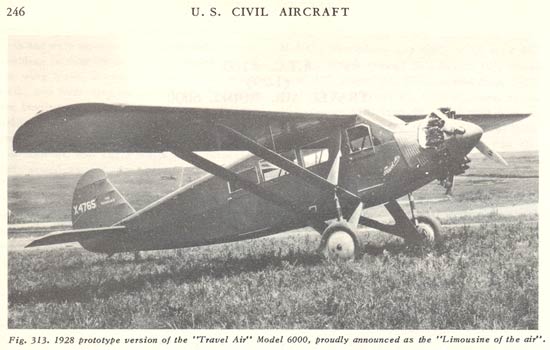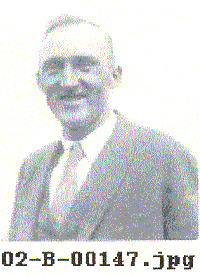|
His Airplane Manufacturing Company is Still in Business
Walter Herschel
Beech was founder, president
and board chairman of the Beech Aircraft Company. He was
born on January 30, 1891 in
Pulaski, TN.
Beech landed at Tucson, arriving from Alamagordo, NM, on
the morning of September 8, 1928. He carried Owen Harned
as passenger in Travel Air NC4765. They stayed 10 minutes
and then were on their way west again to Los
Angeles. Interestingly,
Harned landed at Tucson as a pilot on October 1, 1928, flying
the same airplane, but without Beech. Even more interesting,
I received an email from a site visitor in Texas saying, "The
pilot was my grandfather, Owen Gilbert Harned. He was a salesman
of airplanes." More to come on that.
His career in aviation followed a logical path. He learned
to fly in 1914, was trained in the military and was an Army
pilot, flight instructor and engineer during WWI. In 1920,
he returned to civilian life as a barnstormer.
In 1923, he took a job with the Swallow Airplane Corp. as
designer and pilot. He became general manager. He went out
on his own in 1925 as president and general manager of his
own company, Travel Air. He not only manufactured them,
but he also flew his airplanes successfully in competition
(1926 Ford Reliability Tour, for example). This link provides
an excellent history of the Travel Air company, including
lots of images from the 1920s and 30s.
Image, below, from Juptner (reference, left side bar). This
is the airplane Beech and Harned flew to Tucson.
NX4765 Travel Air 6000
 |
Interestingly, this airplane can be seen on the ground in
an aerial photograph shot by R.T.
Gerow over the Fresno
Airport. See the link for details
of this detective work.
The Travel Air company boomed, and in 1929 was the largest
producer of commercial mono- and biplanes. Beech also had
a prominent hand in producing the low-wing "Mystery Ship"
racer, which became the star of the 1929 National Air Races
when it beat the best of the military aircraft with an attained
speed of 194.9 MPH. It was the first
time a civilian plane defeated a military pursuit in open
speed competition. Undated image, right, from the San Diego Aerospace Museum (left sidebar).
The Mystery Ship introduced the
N.A.C.A. engine cowling and wheel pants to commercial aviation.
In 1930, Frank Hawks flew a Mystery Ship owned by The Texas
Company to over 200 new speed records. The common mantra
later became, "It takes a Beechcraft to beat a Beechcraft."
Beech married Olive Ann Mellor in 1930. In April 1932
the Beech Aircraft Company was started. Olive
Ann Beech co-founded the Company with her husband.
She was Secretary-Treasurer for the firm
beginning in 1932, then became a director in 1936. When Walter
became ill in 1940, she assumed control of the company, but
she was not named president until his death ten years later.
The first Beechcraft airplane
flew in November 1932. In 1934 Beech began production of
the Model 17 Staggerwing. Below, is an image of an advertising
brochure cover for the later Model G17S Staggerwing (Hudgin Family
Collection).
This beautiful biplane,
with its lower wing "staggered" ahead
of the upper wing, not only gave the airplane its striking
good looks, but it also provided a margin of safety in the
stall, as diagrammed in the following image (Hudgin Family
Collection).
In 1937 the
company introduced the twin Beech (Model 18 Transport), as
a contender in the executive and feeder airline transport
field. . In 1938, company sales exceeded $1 million for the
first time.
With WWII, Beech turned his attention to military versions
of his airplanes. They were as successful as his civil aircraft.
By V-J Day, Beech had delivered more than 7,400 military
aircraft and won five Army-Navy "E" awards for production
efficiency. His factory area in mid-1943 was over 1,000,000
square feet, he employed 15,000 people and grossed $150,000,000
per year. The factory facility was immaculate. A sign read,
"If you spit on the floor at home, go home to spit. We want
to keep this place clean."
After WWII, the major news from Beechcraft was the introduction
of the Model 35 Beech Bonanza with a unique "V-Tail." More
recently, the tail design has had its problems in these older
aircraft, and an airworthiness directive has been issued by the government
to strengthen its structure. From the Bonanza line came the
T-34 Mentor trainer for the Air Force, which the Navy also
adopted, and which has also had its share of structural problems with the wings.
Beech died November 29, 1950 in Wichita, KS at age 59 (heart
attack). At the time of his death, he had been active (an
understatement) in aviation for over 30 years.
---o0o---
1926 Ford Reliability Tour
The photo, right, shows Walter Beech in the front cockpit
of the Travel Air BW that he flew to victory in the 1926
Ford Air Tour. The airplane had a Wright J-4 Whirlwind 200
HP engine. Its model designation, "BW" signified this ("B"=
Model B; "W"= Wright engine).
His navigator, Brice Goldsborough
(rear cockpit), was the President of Pioneer Instruments
(note "PI" logo
on the side of the airplane). The aircraft, especially built
by Travel Air for the 2nd Ford Reliability Tour, was manufactured
in 1926. It was co-sponsored through the Tour by Pioneer,
and, according to the link above, left, it was loaded "with
every instrument known to aerial navigation."
For example, a drift measurement device (to measure the
effects of crosswinds) is visible on the left side of the
rear cockpit. You can also see the wind-driven power vane
for the Pioneer Earth Inductor Compass on the mast on top
of the fuselage behind Goldsborough's head. The rear instrument
board contained "modern" vertical readout gauges, while the
front panel contained more standard, round gauges.
Regarding the Earth Inductor Compass, it was considered
at the time to be the most advanced navigational aid available.
Charles Lindbergh used one in the Spirit
of St. Louis a year
later in May 1927. In April of 1929, the price of the compass
installed in a Travel Air was $750. A regular compass cost
$50.
The Tour of 1926 began in Detroit and visited 14 cities
in middle and southwestern states. Twenty-five aircraft began
the Tour and 19 finished. Beech's average speed over the
Tour route was 124.1 MPH and he and Goldsborough earned $2,500
for the win.
Beech credited their success in the 1926 Tour to navigator
Goldsborough and the "fancy
instruments".
Refer to the Forden link cited in the left column for the source
of this image, a map of the 1926 Tour (Forden chapter 2)
and for more information on all the Tours, 1925-1931.
---o0o---
Dossier 2.1.44
UPLOADED: 03/06/06 REVISED: 03/15/06, 11/19/06, 02/04/09, 02/13/09
|







